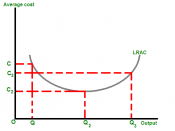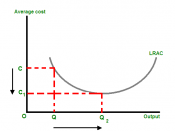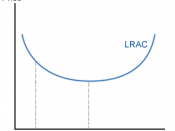Firms achieve internal economies of scale when they are able to decrease average costs per unit of production as the size of their output grows. Economies of scale are known to be present when as output rises, long-run average cost falls. Assuming that there is enough demand for the output produced, the firm can increase its overall profitability by continuing to expand the business while lowering the per unit production costs. The slope of the LRAC curve slopes downward when economies of scale are present and therefore have been achieved by the firm.
Figure 1.0; Internal economies and diseconomies of scale
In figure 1.0, output from OX has increased giving rise to lower per unit production costs. The firm is said to experience internal economies of scale over this range of output.
There are a number of possible sources as to how firms can achieve internal economies. Increased specialization of labour resulting from a larger plant with a larger workforce allows for greater division of labour.
The resulting productivity gains mean lower per unit costs.
As firms expand, it becomes possible for the firms to increase their use of capital by employing more expensive and more efficient machinery. However, it may only be profitable for these firms to use this kind of capital equipment if they produce a very large volume of output.
By purchasing raw materials in bulk quantities, a large firm can often lower the cost of its inputs.
As a result of a firm's greater capacity to develop and produce by-products, a larger firm may be able to make a more economical use of its inputs and may not have excess materials that would otherwise go to waste or be sold off at a discounted price. Small firms are unlikely to have the potential to cut waste...


